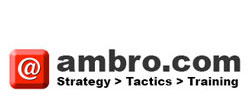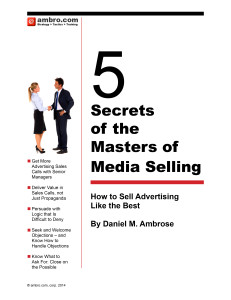Getting Appointments is Hard
After working with thousands of advertising sales managers over the years, perhaps the biggest hurdle to sales effectiveness is the difficulty of getting appointments, or helping their sales team get appointments with the right prospects at the right time to be effective.
If you are thinking about how to sell more advertising, more sales appointments would be a good place to start.
Prospects routinely say they are too busy to meet or that it’s not the right time. Then the right time passes without a meeting, and the prospects proceed without the benefit of the sales call that might have educated them on an important opportunity.
Objections to setting up a meeting itself must be handled like any other objection: Something to be addressed and overcome.
One tactic is to minimize the time commitment of the call by saying something like “It will only take 10 minutes of your valuable time.”
In a recent training seminar I conducted in New York, the group was discussing methods to get over the “too busy to meet” hurdle. I suggested that asking for “just 10 minutes at 5 0’clock” would be very hard for a prospect to turn down.
Then the smartest and most experienced sales person in the room asked “How do you have a good 10-minute ad sales call?” That is the genesis of this post.
The 10-Minute Sales Call is Easy
A proper sales call, in the world of major account advertising sales, following the proven ambro.com Strategic Sales Tactics Training approach, can’t be done in 10 minutes. However, if you know your objective for the sales call, you can reasonably expect to make progress in a step-by-step fashion toward success.
The objective for the 10-minute sales call should be clear; it’s to get the client to agree that there is enough interest to schedule more time. You’ll either get the extra time on the spot or get another meeting scheduled with proper time.
So what is “on the agenda” for a 10-minute sales call? You’ll communicate little if anything about your property. Emphasis should be on showing your client that you understand their situation in a penetrating and valuable way. You need to quickly show that you can add value to their understanding of how to move their own sales needle. If they are convinced you can make them look smarter, and be smarter about their marketing situation, they will make time to learn more.
Getting That Next Appointment is the Only Goal
Some sales people might ask why not jump over the preliminaries and just tell the client without further ado about your media property? Let’s keep in mind you’re only doing a 10-minute sales call on accounts that are hard to crack. They don’t think they are interested. They think they know all they need to know about your property and its category, and they have been living or doing business fine without your property. To close the deal, you’ll eventually need a full-blown sales call to persuade them, from an agreed starting point of their needs, to your logical solution. No needs-agreement, no logic, no sale.
Here is abbreviated play-by-play example of how a successful 10-minute ad sales call could go on a hypothetical new brand of rum:
You: Thank you for squeezing me in. I know how busy you must be, and how demanding your boss might be, so I promise we’ll get this done in the next 9 minutes and we’ll figure out what, if anything, to do next.
Them: Sounds good.
You: The reason I have been so avid to meet with you is because I know you’ve been advertising your new rum on cable, and in these 5 magazines… I’m sure there are other avenues for marketing that you are pursuing, as well, like on-premise promotions and event sponsorships. I assume that you are targeting a younger demographic that is more likely to switch brands than older, more affluent customers. Is that right?
Them: Yes.
You: Since I saw your efforts to target the more dynamic end of the market where brand switchers are found most easily, I took the time to investigate the characteristics of brand switchers and market influencers and how to activate them. I found this article in Harvard Business Review, and this piece of research from the American Marketing Association that shows that these easy-opportunity customers are unique a several ways.
You: How do you take those special demographic nuances into account in your media planning?
Them: We do sampling and table-tents at charity events and blah blah and blah blah.
You: How would it help you if I could assemble a proposal that included more sampling opportunities like that charity events and product launches?
Them: We’re always looking for more opportunities like that.
You: Can we set up a time for me to make a presentation of a complete advertising + sampling proposal to you and your team next week?


Have you tried asking for a 10-minute ad sales call? Tell us your experiences or make your suggestions here.